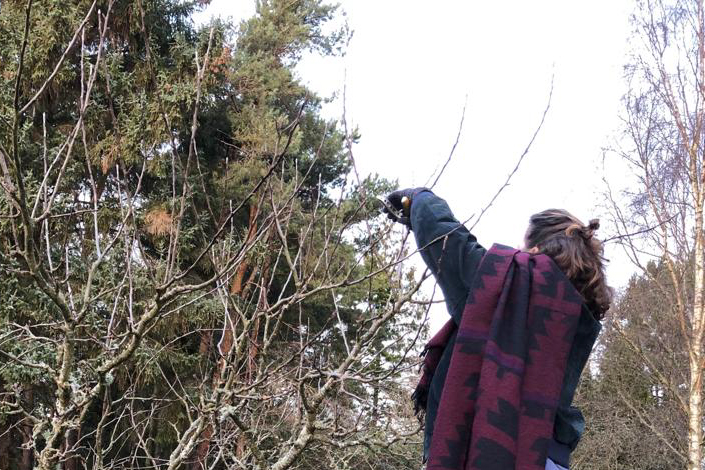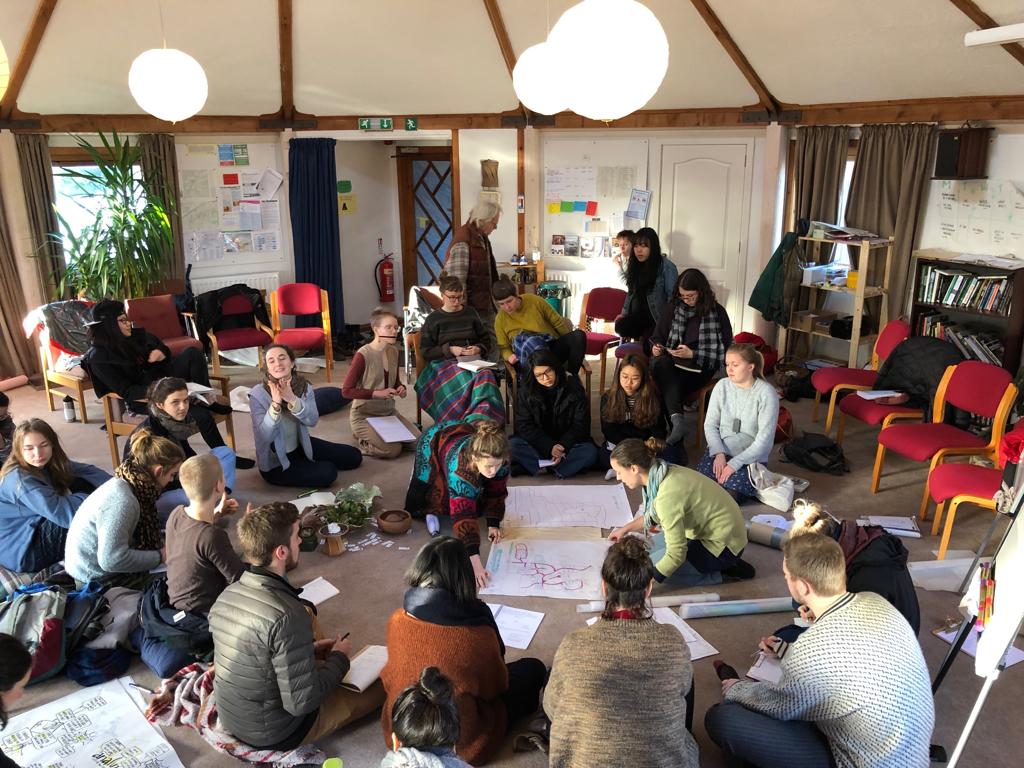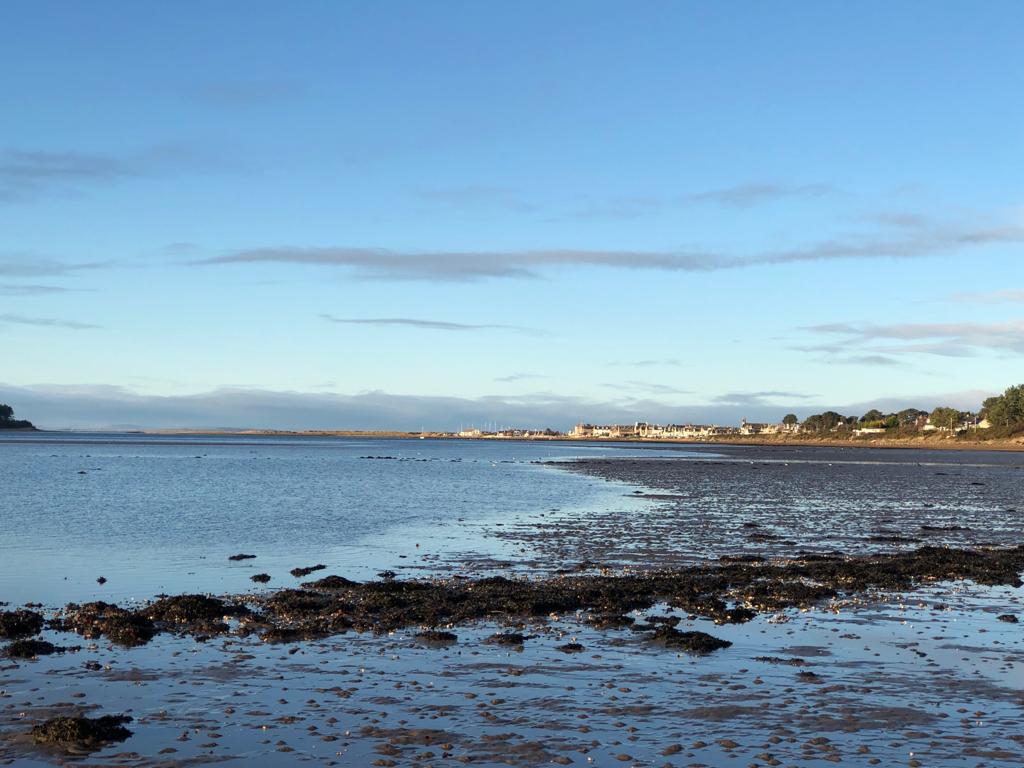Greetings from sunny Scotland that feels a little more like fall than winter. Small flowers are growing and trees still blossoming, yet we were lucky to have a few days of snow for sledding and snow angels. The January newsletter comes later than expected as we wanted to include our reflections on the four week Permaculture Design in full as well as our magical week of Storytelling with Roi and friends Marion and Jappe. A huge thank you to those who have supported YIP11 in their crowd funding campaign for internships and those who are spreading the word about Initiative Forum 2019 – Roots to Routes. We encourage you to visit initiativeforum.yip.se for updates and to buy your early bird tickets soon! More updates will be featured on our instagram @intiativeforum19 so stay tuned. Applications for YIP12 are now open and we appreciate your support in spreading the word. You can direct people to our website or email [email protected] for a template outreach email. In this newsletter you will find: Permaculture Design Course – first week by Camilla Schütt Connecting Permaculture Principles to the Community – second week by Lincoln Hill Experience in Findhorn Foundation Eco Village by Rachael Henry Storytelling with Roi Gal-Or by Naomi Richards
Permaculture Design Course
Slowly people come back to Findhorn filled with their experiences from Christmas break. With the group almost complete we start the Permaculture Design Course, continuing with what we have been starting with before the break. We dive in again into the Permaculture Ethics starting the week with People Care having a day of acknowledging our feelings about how it is to come back, which might be very diffrent from person to person. Also practising some of the Permaculture Principles we Obtain the Yield and harvest some vegetables and herbs in Craig’s and Maria’s garden at the whiskey barrel house for our tea break. Maria is contributor for the Permaculture course and visiting her and Craig’s place and their Permaculture garden is time and again part of the course content. The rest of the day we sing and dance as well as caring, holding and unfolding each others bodies.
The following days we learn about trees in Permaculture and how to prune them, looking deeper on the Principles and Design Frameworks, making a landscape tour around Findhorn and having a presentation about Permaculture in a small business.
The whole week gave us detailed insights in specific areas of how Permaculture can be used and what its underlying structure is based on. That was sometimes confusing or challenging but still very interesting and inspiring to get all these bits and pieces which together form a bigger and very diverse picture of Permaculture.
The second week went on like the first. We looked at many different things each for one morning or aftenoon and sometimes a whole day. We practised our observation skills in nature, learned about water systems and more about the Living Machine, which is doing the cleaning of the grey water in the Findhorn Foundation. We dealt with Permaculture in social systems, in general but also particularily with our group, did reflection on the course so far and voiced what needs we have (for the course and in general) what we can do about it ourselves and what we need from the group and the contributors.
We had a great session were we looked in detail on Maria and Craig’s garden and how Maria’s design process was for this piece of land which we already visited quiet a lot.
We learned about herbs and wild food and made some very nice comfrey balm and a detox ticture. The last thing for this week was how building (houses) can be looked at from a Permaculture perspective and how to integrate them in a Permaculture system/garden.
The week was a lot of information again and we were very ready to get started with our design challenges in the following week and to intergrate as much as possible of the things we learned.
Before we got started we had a great excursion to two different Permaculture projects around Findhorn. It was very inspiring to see how people start their own projects to become self-sufficient and sustainable fr themselves and their surroundings.
The design challenge started on Tuesday afternoon and went on for two and a half days. After spliltting up into five groups with five projects we really dived into the different stages of Permaculture Design.
My group was working on a design for the Original Garden (where the Findhorn Community started). The design was focussed on making the Garden more self-sufficient and catch and store energy especially water.
We started with surveying and creating a base map, going out and observing and collecting all information we could get from the sight as well as from our client Daniela who is responsible for the Original Garden in the Findhorn Foundation.
After starting very stuctured following the stages of design framework of Ga.S.A.D.(I.M.E.T.): goals articulation, survey, analyse, design/decide, (implement, maintain, evaluate, tweak) we moved to a more chaotic and many-things-at-the-same-time-mode. But that wasn’t less productive. We were a group of six people so almost always we split up into smaller groups for focussing on a specific topic, e.g. the water system, more edible plants, finishing maps… It was a very harmonious process. One goal of the group was to focus on people care in our design process because we still had a lot of work to do for Initiative Forum and to do everything at the same time was very challenging.
But in the end we finished our design project satisfying for us and the Original Garden team.
It was inspiring to hear at the end of the week the presentations of all the design projects. I was very impressed how much everybody created in these two and a half days. Written by: Camilla Schütt (YIP11)

Connecting Permaculture Principles to the Community – a second look at Permaculture Design week 2
The second week of our Permaculture Design Course in Findhorn allowed us to experience some of the principals we learned about over the introductory days. These five days showed us the importance of the human elements in permaculture, not only for farming and gardening, but also in our complex web of social relations. We began with a session on social permaculture, relating the network of roots in the soil to those of our social connections. By using a permaculture framework, we discussed a new understanding of group dynamics, domains of power and decision making. This way of seeing was especially exciting and useful for us as we are rounding out our block on community. Shifting back to a land perspective, we discovered the complex and fragile nature of soil. As the basis for life as we know it, we need to build and guard it for our continued existence. We got our hands dirty and observed the content, texture, and pH of differing samples, giving us tools to survey plots of land and increase the fertility of the soil. In the middle of the week, we trundled into a couple vans to meet Tracker Dan at a nearby nature reserve overlooking a beautiful gorge. He enthusiastically led activities that allowed our senses of observation to come through, such as identifying plants by smell and touch. We also had a few moments alone to sit by the roaring river and contemplate the Scottish nature. Continuing with the flow, we spent the afternoon learning about the living machine, a series of large planter tanks that transform wastewater into clear water. Biomatrix, the company who first set it up now specializes in water remediation services and showed us examples of their installations around the world. The next day we spent in the garden and the kitchen, picking and mixing herbs to make ointments and balms. Part of the group also picked copious amounts of horseradish and pickled a a few jars of kraut for Craig and Maria, our hosts. The week came to a close with Tim, who shared his impressive knowledge about the built environment, and how we can make our homes and structures more energy efficient and multifunctional. We learned how to consider different building materials, taking into account their embodied energy from cradle to grave. After discussing topics ranging from passive solar designs to retrofitting older homes, we took on a tour of examples in the Findhorn Park. This week brought us living examples of how we can apply permaculture principles in our landscape designs, but also highlighted how we work as a group, and steps we can take to ensure the strength of the fabric of our community. We turned a corner in our permaculture journey and found new excitement as we moved into the final week of the course, where we finally apply these concepts to a design. Written by: Lincoln Hill (YIP11)

Experience in Findhorn Foundation Eco Village
Imagine you are in the North of Scotland in a place where the wind blows so strong you feel as though it may lift your feet from the ground and topple you over. I think one of most significant aspects of my experience here has been the nature. There is something timeless about the place. The land carries stories of times long gone by. Ageless. The community is swathed in water, on one side lies the bay. A huge green space dotted with pools that fill with water in harmony with the hours of the day and the growing and waning of the moon. An expanse that reminds you of how small you are. Your words get lost in the eerie whistle of wind and the lingering cry of geese. On the other side lies the sea. Waves tumbling to the shore until once again they are reclaimed by depths of emerald blue. Something I feel I have gained from my time here is the art of being fully present. Each activity begins with a tune in, a time to hold hands softening your gaze allowing yourself to let go of all that’s past and all that may come in order to become fully present in that exact moment. Perhaps it’s done a little too often here but there is something special about it that I will carry with me. Written by: Rachael Henry (YIP11)

Storytelling with Roi Gal-Or
Initially, this seemed like an odd placement of course- right at the end of our block on community dynamics. Isn’t storytelling more about the individual, something introspective and contained within the imagination? Yet this week, of all the courses we have had, felt like the most miraculous in just how the group appeared, and shone in a truly new light. It was incredible to witness the transformation that we collectively underwent, how bringing playfulness and a sense of childish wonder into the work we do can have such a profound impact. It was incredibly moving and powerful for me personally to see the impact that the narratives we are surrounded by, and the stories we tell ourselves have on the way that we interact with the world, and with other people. As well as this, I was touched by how relevant stories become to the contexts we place them in. How the same forms and patterns can be observed and replicated across cultures, backgrounds and identities. An ancient arabic proverbial tale can be just as powerful in opening a discussion about modern day conflicts as ever. Stories and their forms can become truly timeless. One tale that particularly stuck with me is one that speaks to the question of: what relevance do stories bring to the current situations we face? Once upon a time, there was an archer who was the very finest archer the land. He never missed a single bulls eye and had totally perfected the art. But he was not satisfied with this, and wanted to find a better archer with whom he could compete, and perhaps hone his skill even further. And so he searched far and wide but could only find archers who were of equally prowess, or, in fact mostly inferior ability. One day the archer came across a village, and immediately noticed something odd… All over the village there were drawn targets, with arrows right in the centre of every single one- now these targets were in the most incredible and difficult locations, one high up on a church tower, another right centre just above the town clock. The archer was amazed and immediately started to enquire of the villages about who this master archer was? No one seemed to know who he was looking for and eventually he sat down by the side of the river, feeling somewhat perplexed and a little defeated. Before long however, he noticed a young girl, of about 12 or 13 walking along the side of the river with a quiver of arrows on her back and a bow slung across her shoulder. He watched as she took an arrow, strung it and the let it fly, where upon it pierced the branch of a tree and stuck there. Then he sat, amazed as she took a piece of chalk from her pocket and proceeded to draw neat rings around the arrow, until a perfect bulls eye had been created, and then continued on her way. The archer sat back and smiled to himself. For me this story shows how we, in our lives, draw our own rings around things. We choose what we make of things. The narratives we tell ourselves and others about the positions we find ourselves in are entirely constructed by us and as humans we have the amazing capacity to change our perspective and to view things in entirely new ways every single day. Written by: Naomi Richards (YIP11)

Roots to Routes Initiative Forum 2019
Hello dear friends. We are excited to announce that the program is developing daily and we will post a more updated and inclusive version by the end of the month so check the website. We are focusing on reconnecting to the roots of wisdom and what is happening in the world and then trying to see what needs to shift in ourselves and our actions to carve new pathways forward into the future. Early bird prices are until March 25. Click here to buy your ticket now! We look forward to seeing you there. CLICK HERE link : https://initiativeforum.yip.se/tickets-if-2019/
Looking forward
At the end of this month, for the February Newsletter, you look forward to: Internship profiles Initiative Forum Updates Welcome to our new team members for YIP11 YIP12 Design update
Until next time!

Sign Up: https://yip.se/news/newsletter/

